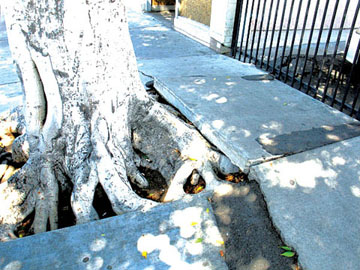Sidewalk $1.4 billion repair program on way

A FAMILIAR SIGHT on Larchmont Blvd. and elsewhere.
In the second week of March, Larchmont Village resident Molly Schiot contacted the Chronicle after witnessing a distressing scene on Larchmont Blvd.
“This morning I was sitting at Go Get Em Tiger and saw an elderly woman, probably in her 80’s, trip and fall on the large, raised crack on the sidewalk,” recalled Schiot.
“She landed smack on her face; her wrist was bleeding and she broke her glasses.” Worse still, Schiot says this is the third fall on Larchmont Blvd. that she’s observed in less than three years.
“It’s very disturbing to witness an elderly person hurt themselves. What do you do? Who do you have to talk to to fix the problem?”
Schiot says she understands the city is under financial pressure, but to her the problem seems to be ongoing with no one taking responsibility.
City Council acts
Unbeknownst to Schiot, just nine days before she witnessed the latest bloody fall, four city councilmen were lobbying support for a sidewalk repair plan in a letter to their colleagues.
“For 40 years, the city of Los Angeles has been stuck with a dysfunctional policy when it comes to sidewalks. There have been many attempts, sometimes valiant, to find a solution to the city’s buckled and broken sidewalks, but there has been no consistent and comprehensive sidewalk repair plan for decades,” read the letter by councilmembers Paul Krekorian, Joe Buscaino, Mike Bonin and Nury Martinez.
Representing the Council’s public works and budget committees, the four councilmen outlined a plan to spend $1.4 billion to fix the city’s broken sidewalks.
Project funding is likely due to a 2015 agreement to resolve the Willits v. City of Los Angeles class action lawsuit, which requires the city to invest more than a $1 billion in city sidewalk repairs and other pedestrian improvements over the next 30 years.
“This is a problem that has been over 40 years in the making and today, the city took a huge step toward fixing it,” said budget chair Paul Krekorian following the committee votes, on March 14.
The 11-point program was unanimously adopted by both committees, and now goes to the full 15-member City Council for approval.
Plan details
Essentially, the plan takes a “fix-and-release” strategy where the city would repair a section of sidewalk and guarantee the work for a period of time, but then hand over responsibility for future maintenance and repair to the abutting property owner. Such private owner responsibility for abutting sidewalks always was the law until a generous city council stepped in to shoulder the burden in the 1970s.
This newly adopted repair program proposes the following essential elements.
After repairs by the city, abutting property owners will have a warranty for repair of future damage (20 years for residential properties and five years for commercial properties) before they are required to cover costs. The city will inspect and certify sidewalks, and prioritize and coordinate repairs. The plan also directs the city to work with council offices for demand-based repair work, and use both the city workforce and private-sector workers. The plan even suggests that the city use the program for workforce development and job training.
Further, the recommendations note that every effort should be made to protect beloved neighborhood trees, and that non-standard sidewalk design and materials be explored. Finally, the plan suggests the city create a partnership between property owners, like a rebate program, to encourage proactive repairs, and the repeal of the Tree Root Exception (a section of Los Angeles Municipal Code that makes it difficult for the city to fairly cite and enforce against sidewalk damage under the 1911 Improvement Act, which governs sidewalks under state law.)
Category: News


